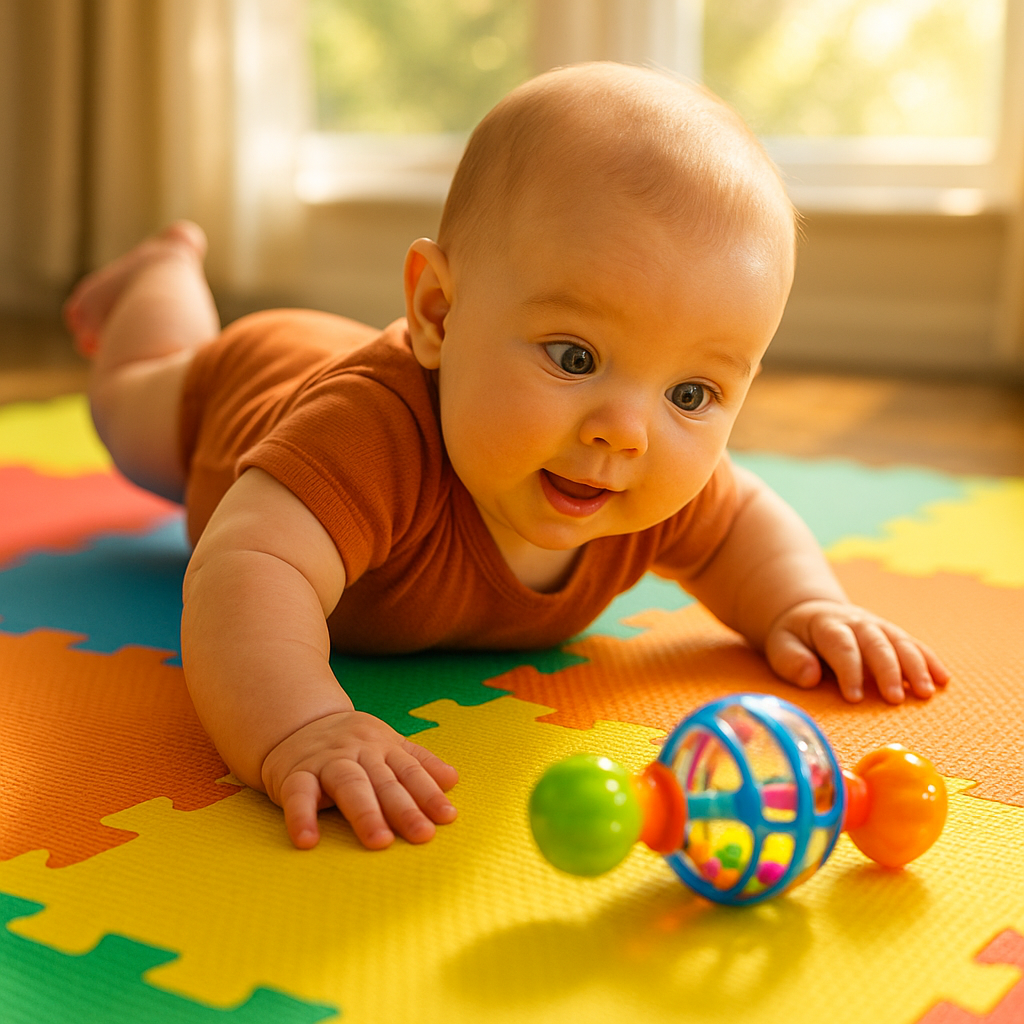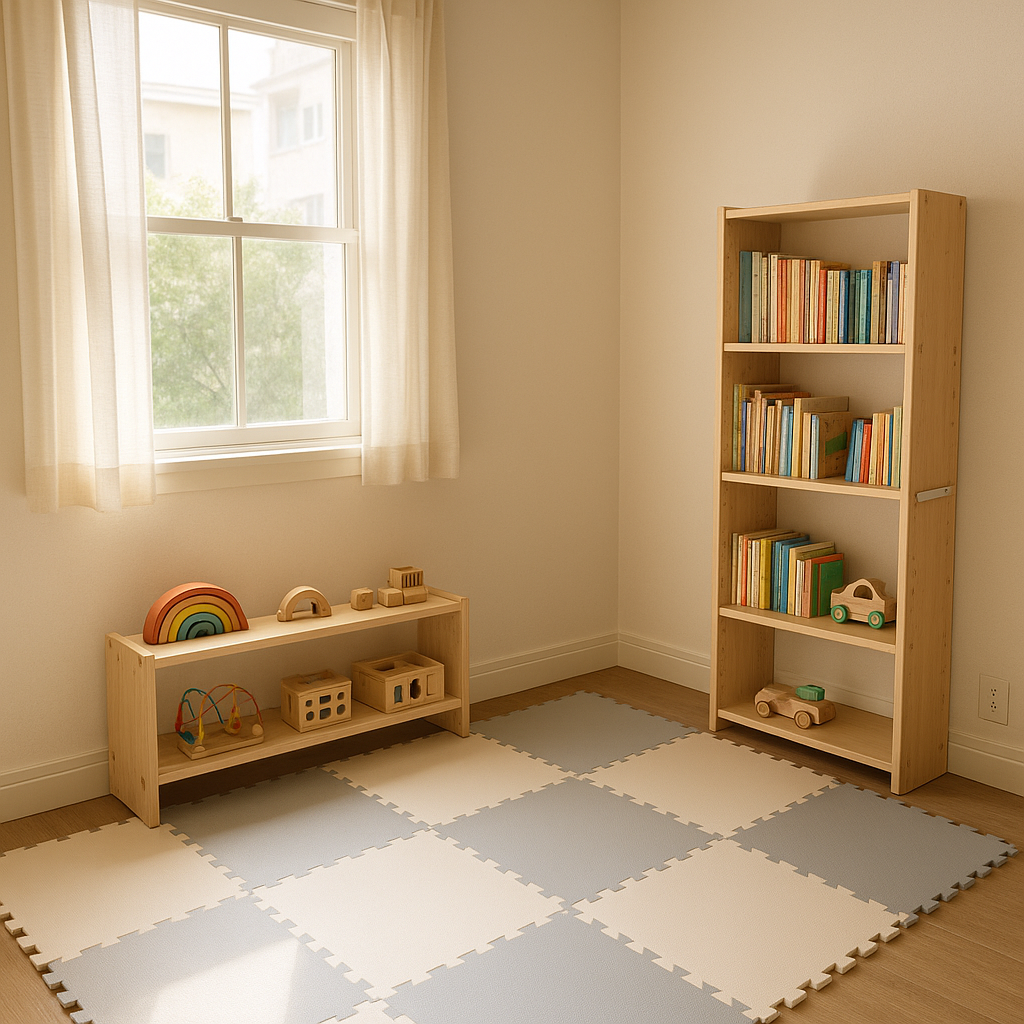Most babies don’t need another gadget to get smarter—they need room to wiggle. When your little one kicks, rolls, and scoots across the living-room floor, every self-directed move sparks neural connections that no swing or bouncer can match.
- Why does free movement build a baby’s brain faster than sitting in gear?
- What exactly counts as “floor time,” and when can you start?
- How does common baby gear affect milestones and cognition?
- How much floor time versus gear time do experts suggest?
- How can busy parents realistically hit those floor-time targets?
- Which simple floor activities supercharge cognitive growth?
- Is any baby gear actually helpful when used wisely?
- How do you set up a brain-boosting floor space in tight or shared homes?
- Do walkers and jumpers really speed up walking?
- What red flags suggest too much gear or too little movement?
- Rapid-fire answers to parents’ top questions
- Final Thoughts
Why does free movement build a baby’s brain faster than sitting in gear?
Short answer: Unrestricted floor play drives more synapses, reflex integration, and problem-solving than passive gear time.
When babies initiate their own movements, sensory feedback floods the brain, strengthening motor pathways and mirror-neuron networks. Each push-up during tummy time maps body position (proprioception) and space, laying groundwork for later language, math, and emotional regulation. Studies also link well-integrated primitive reflexes—achieved through free movement—to smoother reading and coordination in preschool. See primitive reflex integration and motor development
Play vs. TV: Why Active Learning Boosts Baby’s Brain dives deeper into the science of active exploration.

What exactly counts as “floor time,” and when can you start?
Any supervised play on a firm, safe surface qualifies—on the back, tummy, side-lying, or crawling. Begin from birth with 3- to 5-minute sessions, especially chest-to-chest tummy time, and lengthen as tolerance grows. Pediatric therapists call 88 minutes of tummy time per day by 6 months the “gold standard” for core strength and reflex integration. Need ideas? Check out Tummy Time Benefits: Boosting Your Baby’s Brain Early.
How does common baby gear affect milestones and cognition?
Gear restricts practice. Muscle groups that should learn to balance and bear weight stay idle, so sitting, crawling, and walking can slide weeks—or months—behind.
| Gear Type | Movement Allowed | Therapist Rating* | Key Developmental Risk |
|---|---|---|---|
| Exersaucer / Activity Center | Minimal leg flexion | Highly detrimental | Toe-walking, delayed cruising |
| Walker (wheeled) | Assisted pseudo-walking | Highly detrimental | 2,000 ER visits/year; gait issues |
| Bouncer / Swing | None (reclined) | Moderately detrimental | Flat head, low core strength |
| Bumbo-style Seat | Fixed sitting | Moderately detrimental | Weak trunk, poor posture |
Is my baby gear stunting their development?
How much floor time versus gear time do experts suggest?
Aim for a 2-to-1 ratio—two minutes on the floor for every minute in gear. Many pediatric OTs go further: keep all containers under 15 minutes at a stretch and under 60 minutes total per day. A sample day:
- 4 months: nine 10-minute floor bursts + three 10-minute gear breaks.
- 8 months: six 15-minute floor sessions + two short high-chair feeds.
- 12 months: floor play dominates; gear limited to travel or meals.
For fostering self-directed focus, see Montessori for Babies: Encouraging Independent Play.
How can busy parents realistically hit those floor-time targets?
• Create a “yes space” with a play yard or foam tiles where baby can’t find trouble.
• Place a foldable mat in the kitchen; narrate meal prep to build language (“I’m stirring the soup”).
• Use baby-wearing as a bridge when hands must be free—gentle motion still feeds the vestibular system.
• Draft an older sibling as a “floor buddy” for social and speech benefits.
• Break 90 minutes into nine 10-minute micro-sessions sprinkled through wake windows.
Which simple floor activities supercharge cognitive growth?
Rotate high-impact, low-cost ideas:
- Sensory baskets filled with crinkly fabric, wooden spoons, and silicone lids.
- Peek-a-boo for object permanence—see Peek-a-Boo Games: Teaching Your Baby Object Permanence.
- Cause-and-effect play with stacking cups—details in Blocks and Cups: Boosting Your Baby’s Spatial Skills.
- Rhythm sessions: tap wooden spoons while streaming gentle beats, tying into Music for Babies: Does It Boost Brain Development?.
- Mirror play to spark self-recognition and emotional awareness.
Is any baby gear actually helpful when used wisely?
Yes—dynamic, not static, equipment can complement floor play. Soft-structured carriers move with your body, challenging baby’s balance. Flat floor mats and stationary play yards protect without pinning limbs. Feeding seats or travel systems serve specific tasks; just limit duration and choose designs with open hip angles and flat bases.
Checklist for gear that supports development:
- Flat, firm base (no molded bucket).
- Open hip position >90°.
- Allows visual access to surroundings.
- Easy in-and-out for quick floor transitions.
- Clear safety certifications.
“Containers aren’t evil; overuse is,” reminds OT Bree Milani.
How do you set up a brain-boosting floor space in tight or shared homes?
Even a city studio can host robust play. Roll out trifold foam tiles that slide under the couch by night. Mount low shelves for toys; stash extras in a rolling cart. Anchor furniture, cover outlets, and outline the play zone with bright painter’s tape so siblings know the baby’s turf.

Do walkers and jumpers really speed up walking?
No. Research shows walkers don’t accelerate milestones; they often delay them and can encourage toe-walking. Canada banned wheeled walkers in 2018 because of injury risk. Read review on baby walkers and delayed motor development. True walking emerges only after babies pull to stand, cruise, and practice balanced steps—skills learned best on the floor with sturdy furniture for support.
What red flags suggest too much gear or too little movement?
Watch for these cues:
- Flat spots on the skull after 3 months.
- Head always tilted to one side (torticollis).
- No rolling by 6 months.
- Toe-walking once cruising.
- Resistance to tummy time despite gradual exposure.
If any appear, track daily gear minutes, boost floor play, and consult a pediatric PT or OT.
Rapid-fire answers to parents’ top questions
-
When should I start floor time?
From day one. Begin with chest-to-chest tummy time and short back-lying stretches on a firm surface. -
My baby hates tummy time—what now?
Try incline tummy time over a rolled towel or nursing pillow, keep sessions brief, and increase frequency rather than length. -
Is an activity mat considered gear?
Only if it restricts movement. Flat mats invite exploration; molded loungers do not. -
Can floor time replace baby gyms?
Absolutely. A scarf to wave, a pot to bang, or a cardboard box rivals any pricey gym. Get more ideas in DIY Baby Toys: Budget-Friendly Brain Boosters. -
How long until I see benefits?
Improvements in head control often appear within two weeks of consistent daily floor play.
Final Thoughts
Choosing the floor over containers isn’t a minimalist fad—it’s a proven, low-cost way to fire up your baby’s growing brain. Ready for more inspiration? Explore 15 additional ideas in Boost Your Baby’s Brain Power: 15 Activities to Boost Baby Brain Development. Every minute you give your child to move freely is a vote for confidence, curiosity, and lifelong learning—and that’s a gift no gadget can match.